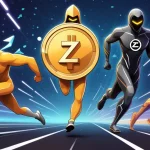Remittix, Cardano, Chainlink, Polkadot: Top Crypto Picks for Q4 2024 or Hype Traps?

Remittix, Cardano, Chainlink, Polkadot: Best Crypto Investments for Q4 2024 or Just Hype Machines?
With the final quarter of 2024 upon us, the cryptocurrency market is crackling with speculative fever. Four projects—Remittix, Cardano, Chainlink, and Polkadot—are being touted as prime picks for high returns. But are these assets truly poised to disrupt the financial landscape, or are they just shiny distractions from Bitcoin’s unshakeable dominance? Let’s dissect what’s driving the buzz, cut through the noise, and weigh their potential against their pitfalls with a clear-eyed view.
- Remittix: A PayFi newcomer with a $27.2M presale haul and major exchange listings lined up.
- Cardano: A layer-1 blockchain with growing ecosystem traction and institutional interest.
- Chainlink: A critical data bridge for real-world asset tokenization with significant upside potential.
- Polkadot: An interoperability player pushing DeFi innovations under the radar.
Bitcoin as the Gold Standard: Why Altcoins Must Prove Themselves
Before diving into these altcoins, let’s ground ourselves in the reality that Bitcoin remains the king of decentralization. As the first and most secure cryptocurrency, Bitcoin isn’t just a speculative asset—it’s a middle finger to centralized financial systems, a store of value that no government can seize, and a beacon of privacy and freedom. Its proof-of-work consensus ensures an immutable ledger, unlike many altcoins that chase fleeting trends with questionable staying power. Any project vying for portfolio space must offer something Bitcoin can’t or won’t—be it scalability, utility, or niche innovation. With that lens, let’s see if Remittix, Cardano, Chainlink, and Polkadot measure up or merely ride BTC’s coattails during market pumps.
Remittix: PayFi Promise or Presale Cash Grab?
What’s the Buzz?
Remittix is the new kid on the block, branding itself as a PayFi project—short for Payment Finance, a concept blending decentralized finance with seamless payment systems to make crypto transactions as easy as swiping a card. It has raised a staggering $27.2 million in its presale by selling 677 million tokens at $0.1130 each. Listings on centralized exchanges like Bitmart and LBank are confirmed, with rumors of another major platform in the works. Security credentials are solid, with Remittix ranking #1 on CertiK Skynet for pre-launch tokens and earning full KYC verification from CertiK, a respected blockchain auditing firm. For the unfamiliar, KYC (Know Your Customer) verification means the team behind Remittix has been vetted for legitimacy, a rare stamp of trust in a space rife with anonymous scammers.
Product-wise, Remittix isn’t just selling promises. Its Wallet Beta is live, with a second update already rolled out based on tester feedback. A web app for crypto-to-fiat transactions—converting digital assets to cash or vice versa—is nearing its Q4 beta launch. They’re even tossing out a 15% USDT referral reward, claimable daily, to sweeten the deal. On paper, this looks like a project with legs, targeting a real pain point: the clunky process of using crypto in everyday life. If you’re curious about why projects like Remittix are considered top picks for high ROI, their innovative approach to payments is a key factor.
Risks and Red Flags
But let’s slam the brakes on the hype train. Presales are the Wild West of crypto—flashy numbers often mask shaky foundations. Raising $27 million is a flex, sure, but we’ve seen projects like Bitconnect in 2017 pull in millions only to collapse in spectacular fraud. Without public details on tokenomics, vesting schedules, or the team’s track record, Remittix could be a gilded cage waiting to trap eager investors. Is PayFi even a viable niche, or just a buzzword to lure in suckers? Crypto-to-fiat solutions face massive regulatory hurdles—governments aren’t keen on tech that bypasses their control. If the web app flops or listings don’t spark demand, this could be another rug-pull waiting to happen.
Relevance to Decentralization
From a decentralization standpoint, Remittix’s goal of bridging crypto and fiat could push mainstream adoption, a key step toward financial freedom. If it delivers, it might empower users to ditch banks for daily transactions. But centralized exchange listings and fiat integration risk cozying up to the very systems we’re trying to disrupt. Is this a trojan horse for centralization under a DeFi guise? Only time—and a damn good whitepaper—will tell.
Cardano: Slow and Steady or Too Slow to Matter?
What’s Driving Interest?
Cardano (ADA), a layer-1 blockchain designed as a scalable, research-driven alternative to Ethereum, is showing signs of life in Q4. Built on a proof-of-stake consensus—far less energy-hungry than Bitcoin’s proof-of-work—Cardano aims to support smart contracts and decentralized apps (dApps) with lower fees and faster transactions. Its price is hovering near critical levels, with growing optimism fueled by rumors of ETF inclusion, akin to the Bitcoin ETFs that brought institutional cash flooding in. Integrations like support in the Brave Wallet (a browser-based crypto wallet tied to the privacy-focused Brave browser) and cross-chain swaps with NEAR Protocol across over 20 blockchains are expanding its ecosystem. Whale activity—large investors buying in bulk—is reportedly rising, and exposure through Nasdaq indices adds a layer of traditional finance credibility.
Technical Breakdown and Growth Catalysts
Cardano’s appeal lies in its methodical approach. Unlike many projects that rush half-baked tech to market, Cardano’s development is peer-reviewed and academic, prioritizing security over speed. The Brave integration means users can hold and spend ADA directly from their browser, lowering the entry barrier. Cross-chain swaps with NEAR, a competing blockchain focused on scalability, enhance liquidity by letting ADA move seamlessly across networks, a boon for DeFi users. ETF speculation, if realized, could mirror Bitcoin’s 2021 surge post-ETF approvals, though nothing is confirmed. These factors suggest Cardano might carve out a bigger slice of the layer-1 pie, challenging Ethereum’s dominance.
Risks and Red Flags
Here’s the bitter pill: Cardano’s history is littered with delays and unfulfilled hype. Its smart contract rollout took years, and dApp adoption still lags behind Ethereum and newer players like Solana. The 2017-2018 bull run saw ADA pumped on promises alone, only to crash hard. ETF talk is just gossip—don’t bank on it. Even with whale buys, market sentiment can turn on a dime, especially if Bitcoin stumbles. Cardano’s slow pace might be a feature for stability, but in a breakneck industry, it could be a fatal flaw. Is this a project for patient visionaries or a relic outpaced by hungrier rivals?
Relevance to Decentralization
Cardano’s energy-efficient design and focus on scalability align with the ethos of accessible, decentralized systems. If it gains traction, it could offer a viable platform for dApps that empower users over corporations. Yet, its academic bent and corporate-friendly moves (like Nasdaq exposure) raise questions: is this truly a tool for the people, or a sanitized blockchain for suits? Compared to Bitcoin’s raw, unstoppable sovereignty, Cardano feels like a compromise.
Chainlink: Oracle King or Centralized Chokepoint?
What’s the Big Deal?
Chainlink (LINK) is the heavyweight in the oracle space, providing the data bridges—known as oracles—that feed real-world information like stock prices, weather data, or government stats into blockchain smart contracts. Without oracles, blockchains are isolated islands; Chainlink makes them relevant to the outside world. Its role in real-world asset (RWA) tokenization—turning physical assets like real estate or commodities into digital tokens—is massive, with partnerships through its BUILD program driving adoption. Think tokenized property deeds or gold reserves verifiable on-chain—Chainlink’s data pipelines make this possible. Growing use in government and corporate sectors signals it’s not just a crypto niche but a foundational tech layer.
Technical Edge and Market Potential
Chainlink’s decentralized oracle network mitigates single points of failure by pulling data from multiple sources, a critical edge over centralized alternatives. Its integration with major blockchains like Ethereum and newer ones via BUILD partnerships (supporting projects building on Chainlink tech) cements its utility. If RWA tokenization explodes—potentially unlocking trillions in value as traditional assets go on-chain—Chainlink stands to benefit disproportionately. Some speculate significant price upside if market momentum builds, especially with dips seen as buying opportunities. But let’s not get lost in moonboy fantasies—value comes from adoption, not blind hope.
Risks and Red Flags
Chainlink’s dominance is both strength and weakness. If DeFi and RWAs over-rely on its oracles, it becomes a centralized chokepoint in a supposedly decentralized ecosystem—a juicy target for hacks or regulatory crackdowns. Competitors like Band Protocol and API3 are hungry to chip away at its market share with cheaper or more specialized solutions. Adoption doesn’t always equal price gains; fundamentals can lag behind speculation in crypto’s irrational markets. And let’s not ignore the elephant in the room: if institutions dominate RWA tokenization, Chainlink could end up serving the old guard rather than disrupting it. Utopia or dystopia? You decide.
Relevance to Decentralization
Chainlink’s oracles are indispensable for DeFi’s growth, enabling trustless systems that could dismantle centralized finance. Imagine smart contracts replacing shady middlemen in insurance or loans—Chainlink makes that feasible. But its pivotal role risks creating a new monopoly. Bitcoin doesn’t need oracles to assert its independence; Chainlink’s utility might be a necessary evil, but it’s a far cry from BTC’s pure, permissionless ethos. Does it complement the revolution or complicate it?
Polkadot: Interoperability Innovator or Overcomplicated Mess?
What’s Cooking?
Polkadot (DOT) often lurks in the shadows of flashier altcoins, but it’s a serious contender in the interoperability game. Its design as a multi-chain protocol allows different blockchains to communicate and share data through a central relay chain and connected “parachains.” This solves a real problem: blockchains like Bitcoin and Ethereum don’t naturally play nice, limiting DeFi and dApp potential. Polkadot’s price has clawed above $4.00, with catalysts like the pUSD proposal—a stablecoin backed by DOT to lock liquidity within its ecosystem—driving interest. Upcoming upgrades like elastic scaling (adjusting capacity dynamically) and XCM (cross-consensus messaging) enhancements bolster its technical chops.
Technical Breakdown and DeFi Potential
Polkadot’s parachain model contrasts with competitors like Cosmos, which uses an IBC (Inter-Blockchain Communication) protocol. Polkadot’s centralized relay chain offers tighter security but less autonomy for connected chains, while Cosmos prioritizes sovereignty. The pUSD stablecoin could be a game-changer for DeFi within Polkadot, creating internal demand for DOT as collateral—think MakerDAO’s DAI but native to this ecosystem. XCM upgrades mean smoother data and asset transfers across chains, potentially making Polkadot a hub for cross-blockchain activity. If executed well, this could position DOT as a quiet giant.
Risks and Red Flags
Polkadot’s biggest hurdle is its complexity. Interoperability sounds sexy, but developers often stick to simpler ecosystems like Ethereum or Solana for ease of use. Adoption of parachains remains sluggish compared to rivals, and the pUSD concept faces a crowded stablecoin market plus looming regulatory heat—governments hate anything that mimics currency outside their grip. Polkadot’s under-the-radar status might keep it safe from hype crashes, but it also means less community buzz to drive momentum. Compared to Bitcoin’s straightforward “be your own bank” narrative, DOT’s tech-heavy pitch feels like a niche for geeks, not the masses.
Relevance to Decentralization
Polkadot’s vision of a connected blockchain web is a direct challenge to centralized gatekeepers who profit from siloed systems. If successful, it could enable a truly decentralized internet of value, where users move assets freely across networks. But its intricate design and slow uptake risk making it a solution in search of a problem. Bitcoin doesn’t need interoperability to disrupt—Polkadot’s relevance hinges on whether the industry even wants this level of integration or prefers Bitcoin’s isolated strength.
External Forces: Regulation and Market Risks in Q4 2024
Beyond individual project dynamics, Q4 2024 brings external pressures that could make or break these altcoins. Regulatory scrutiny is tightening globally—the U.S. SEC continues to classify many tokens as securities, potentially hammering presale projects like Remittix with legal battles. The EU’s MiCA (Markets in Crypto-Assets) framework, rolling out in phases, imposes strict compliance on exchanges and stablecoins, which could dent Polkadot’s pUSD ambitions or Chainlink’s RWA integrations. Macroeconomic headwinds, like persistent inflation or interest rate hikes, often push investors toward safer assets, leaving altcoins bleeding while Bitcoin holds as a digital gold. A BTC dump could drag the entire market down, diversified portfolio or not. These aren’t hypotheticals—they’re the harsh realities of a space still fighting for legitimacy against entrenched powers. Any investment strategy ignoring these risks is just gambling with extra steps.
Diversification: Balancing Risk or Chasing Shadows?
Spreading bets across Remittix’s speculative PayFi gamble, Cardano’s steady layer-1 growth, Chainlink’s proven utility, and Polkadot’s interoperability play might mitigate volatility compared to an all-in wager on one asset. It mirrors the ethos of not just surviving but thriving in a chaotic market—mixing high-risk, high-reward with grounded fundamentals. But let’s not kid ourselves: diversification in crypto isn’t a shield against systemic crashes. When Bitcoin sneezes, altcoins catch pneumonia. And with regulatory swords dangling overhead, even a balanced basket can turn to ash overnight. If you’re allocating funds here, keep Bitcoin as your anchor—its resilience is unmatched. These altcoins might spice up returns, but they’re side dishes, not the main course. Invest only what you can afford to see vanish, because in this game, even the smartest plays can burn.
Key Questions for Crypto Investors
- What makes Remittix a potential standout in the crypto space?
Remittix’s $27.2 million presale, listings on Bitmart and LBank, and CertiK verification highlight it as a PayFi innovator for crypto-to-fiat transactions, though unproven tech and regulatory risks cast doubt on its longevity. - Is Cardano a viable contender for Q4 growth?
Cardano’s ecosystem expansion via Brave Wallet, NEAR swaps, and ETF speculation positions it for gains, but its history of delays and sluggish dApp adoption temper expectations against faster rivals. - Why is Chainlink pivotal to blockchain’s future?
Chainlink’s oracles underpin DeFi and real-world asset tokenization by connecting blockchains to external data, making it indispensable—yet its dominance risks centralization and competition looms large. - Can Polkadot’s innovations spark significant adoption?
Polkadot’s interoperability via parachains and DeFi plays like pUSD could make it a cross-chain hub, but its complex design and slow developer uptake hinder mainstream traction compared to simpler ecosystems. - Should investors diversify across altcoins or stick to Bitcoin?
Diversifying across these projects balances speculative upside with utility, but Bitcoin’s unmatched security and decentralization make it the safer core holding—altcoins are volatile bets, not guarantees.
As we navigate Q4 2024, remember that the crypto frontier is as brutal as it is exhilarating. Bitcoin remains the bedrock of freedom and privacy, the ultimate fuck-you to centralized control. Altcoins like Remittix, Cardano, Chainlink, and Polkadot offer tantalizing possibilities—some as tools to accelerate decentralized innovation, others as potential traps for the naive. Approach with skepticism, dig into the tech, and never forget that in this space, fortunes are made and lost on the edge of a knife. Let’s champion the revolution, but let’s do it with eyes wide open and wallets guarded tight.



